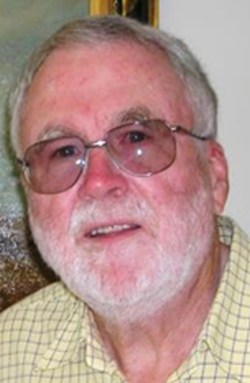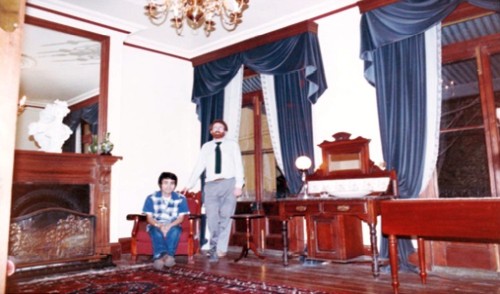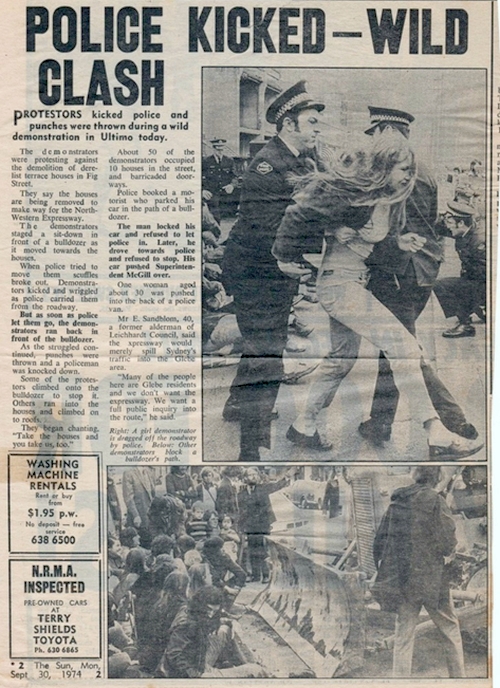Recollections of a Glebe Society founding member

A member of the Glebe Society recently told me of the 50th anniversary celebrations to be held this year. The internet site for the Society shows all of the wonderful work you are now doing. Amazing to me is that you have on-line all of the Society’s Bulletins back to the very first one in July 1969 – all wonderfully accessible at the click of a button by year and issue. And these of course have brought back many memories and emotions.
I was a founding member of the Society in 1969 attending the first meetings at the homes of Bernard Smith (1916-2011) and Kate (Challis) Smith (1915-1989) at 23 Avenue Rd and Rob and Sandra Darroch in Toxteth Rd. Old records of mine show that I was a paid up member at the time of the first General Meeting of the Society on June 19, 1969 at $2! As a piece of trivia comparison the 1969 annual fee for the National Trust was $3, Choice Magazine $4 and the NSW Ambulance Service $3.
In December 1966 I started work at age 21 as a planning assistant with the then new State Planning Authority of NSW on the fourth floor of the Mark Foys Building in Goulburn St. In 1968 I moved to Glebe to be closer to work and the University where I was completing a degree. At first I lived in a student share house at 131 St Johns Rd, immediately opposite the Glebe Town Hall (every room a bedroom except the kitchen!). This house was owned by a friend and fellow trainee town planner and later landscape architect, garden presenter, writer and lecturer, John Stowar.
I was enchanted with Glebe from the beginning. Prior to 1968 I was still living at home in then semi-rural Prospect and knew very little about inner city life. Early in 1968 I was to see Paddington for the very first time. This came about as I was seconded to assist architect Walter Bunning who held a seminal NSW inquiry into the new roadway proposals affecting that suburb. These road proposals were strongly opposed by the Paddington Society and of course the Paddington Society itself became a model for setting up the Glebe Society shortly afterwards. The Bunning Inquiry ran for 5 days in the Sydney Town Hall. It heard 54 witnesses including representatives from the Paddington Society. Bunning submitted his final report in March 1968 and recommended that Paddington should be declared an historical area and protected from highway development.
In 1970 I moved to another student house run by Terry Metherell but owned by Eric and Jan Sandblom at 140 Hereford St. In 1971 I bought my first house at 3 Rosebank St – no more student lodgings! In 1975 I bought 133 St Johns Rd from architect/planner, Stafford Watts. I moved to 133 with my then partner, fellow trainee town planner and early advocate and writer on heritage conservation and later university lecturer, Stephen Harris. By that time John Stowar had sold his house at No.131 to Marie Webb and some time later a friend, Dr John Boully, an early advocate of community based medical services for Aboriginal and disadvantaged people, bought No 135. Over the years we removed the dividing fences to Nos 131, 133 and 135 St Johns Rd to create a much wider back garden than each 15-foot terrace allowed. You will not be surprised to hear that almost all of the people mentioned in this paragraph were early members of the Glebe Society nor that my solicitor was Max Solling!

I have many fond memories of the 19 years I lived in Glebe and of my association with the early times of the Glebe Society and I would like to share some of these memories with you. From the Bulletin I have noted the memoirs and interviews of other early members including the late and much admired and respected Albert Mispel. Over a period of 50 years memory can play tricks so I have been as careful as possible to check what I have to say against other sources including the Society’s Bulletins.
I was active in the early days of the Society in its endeavours to conserve Glebe, including major opposition to freeway proposals, indiscriminate home unit development and the total redevelopment of the Anglican Church Glebe lands. In recording these notes I have concentrated on the matters I was involved in, and to a large extent on my contribution, as this is what I know more about. The reality is that none of the successes recorded in this memoir were possible without the many people, including members of the Glebe Society, who actively gave their time, worked together and made a difference. Again the Glebe Society’s Bulletins provide a good record of those who made such a contribution.
My involvements in the early days can be summarised as follows:
- in June1969 as first convenor of the Society’s planning committee (I was succeeded in April 1970 by Albert Mispel);
- in 1970 as co-author with Terry Metherell of the first plan to address indiscriminate home unit development in Glebe;
- in 1971 and 1974 as a Campaign for Better Council candidate in Lilyfield Ward, one of six wards in the then Leichhardt Council area;
- in 1974 in taking an active part in opposing the North Western distributor including at a critical demonstration in Fig St Ultimo; and
- in 1975-1977 as worker and chair on the Leichhardt Local community newspaper.
I would like to say a little bit more on each of these.
1. First convenor of the Society’s planning committee
In regard to the planning committee, the first Glebe Society Bulletin produced in July 1969 records that:
On Sunday, June 29, the Glebe Society’s Town Planning Subcommittee held its first meeting. The convenor, Dennis McManus outlined the main threats to the suburb, and the changes to come. The major issues discussed included the effect of the Department of Main Roads expressways; the development of the harbour foreshore land (at present occupied by timber yards); the Church of England redevelopment project; the need for more open space and recreational facilities; the need to encourage more tree planting and tree conservation; the better utilisation of the existing street pattern and the problem of industrial development.
Three work groups – ROADS, BUILDINGS and RECREATION – were formed to deal with these problems. One of the pressing concerns of the Buildings group will be to investigate and report on home unit development in the Glebe area. Home unit construction is accelerating and is regulated by the least satisfactory building code in perhaps the whole of the Sydney area – one which allows flat buildings to be constructed on lots down to 40 feet in width and an area of 2,500 square feet.
The Recreation group will look into the question of the lopping of trees which occurred recently in Talfourd St and Gottenham St. The Roads group will Iook closely into the Department of Main Roads expressway proposals. The next meeting of the Town Planning Subcommittee will be held at I40 Hereford St, home of Eric Sandblom, on Sunday 13 July 1969 at 7.30 pm. The convenor of the Town Planning Committee, Dennis McManus can be contacted at 131 St Johns Rd, Glebe.
2. The first plan to address indiscriminate home unit development
In early 1970 Terry Metherell (well known in later years as NSW Minister for Education 1988-1990) and I drew up a plan to address the issue of indiscriminate home unit building in Glebe. This plan is set out in the Bulletin, 1970, Issue 1. The plan consisted of one large sheet with text of 306 words to one side setting out its aims. While I am proud of the few words, given my later career in town planning and heritage, I am somewhat embarrassed by the naivety of the plan. In my defence I need to say that there was no concept of conservation areas at that time and it did succeed as the basis for discussion with both the Council and the State Planning Authority and it did lead to much better plans for Glebe and the whole of Leichhardt in the future.
3. Campaign for Better Council candidate in Lilyfield Ward
In Glebe, Balmain (Balmain Association formed 1966) and Annandale (Annandale Association formed 1969) there was increasing realisation that no serious change would come about without changing Leichhardt Council which then appeared both corrupt and bereft of good ideas. A Campaign for a Better Council was formed to contest the September 1971 local government elections. To be effective it was realised that candidates must be run in all six wards – Glebe, Annandale, Leichhardt, Lilyfield, Rozelle and Balmain – each of which had two elected alderman. I ran as the second candidate on the ticket for Lilyfield Ward in both 1971 and 1974 and on each occasion our first on the ticket was elected – Ernie McIlveen in 1971 and Tina Colston in 1974. In both 1971 and 1974 we walked every street in Lilyfield talking to voters and handing out leaflets. The good election results were a game changer for the environment. The well-known former Alderman Issy Wyner in a speech given at the Leichhardt Town Hall on 26 August, 2002 had this to say about the 1971 council:
If I were to seek a highlight in my somewhat chequered career, it would certainly be the 1971 introduction in Leichhardt of the Open Council Concept, which pointed the way to participatory democracy in its ultimate form: decision-making by the people who would be affected by the decision. As one of the seven (out of twelve aldermen) who agreed to open Council proceedings to the public, it was exhilarating to work with Nick Origlass, Philip Bray, Eric Sandblom, David Young, Ernie McIlveen and Bill Dougherty, in allowing the winds of change to blow through the musty corridors of local government in Leichhardt. (https://www.labourhistory.org.au/hummer/vol-3-no-9/living-legend/)
Of the several good accounts of the politics in Leichhardt at that time perhaps the most clearly researched and accessible, free on line, is that by Tony Harris, Basket Weavers and True Believers, Making and Unmaking the Labor Left in Leichhardt Municipality c.1970-1991.

4. Opposing the North Western distributor including at a critical demonstration in Fig St Ultimo
In the 1970s the Glebe Society was directly involved in opposing both the Western and North Western Freeway proposals. The massive impact of these roads is shown very clearly in the 1968 Sydney Planning Scheme map shown in a 2017 Bulletin at https://www.glebesociety.org.au/albert-mispel-1938-2017-glebe-owes-him-a-large-debt
In the case of the North Western Freeway proposal for a viaduct across Wentworth Park and a tunnel under Glebe Point there was an on site protest at the demolition of houses in Fig St, Ultimo on Monday September 30, 1974 as reported in The Sun that same day. The article includes the comment that:
Police booked a motorist who parked his car in the path of a bulldozer. The man locked his car and refused to let police in. Later, he drove towards the police and refused to stop. His car pushed Superintendent Gill over.
Forty-five years later, I can reveal that the man in the car was me! The Sun’s reporting was parsimonious with the truth and of course Superintendent Gill was never pushed over. This is acknowledged by the fact that I only received a parking fine. One amusing event happened while waiting for the police to obtain a hammer to smash my car window – bystanders threw money into my car to pay for the parking fine! It was a successful protest and three years later the Western Freeway was abandoned by the Department of Main Roads and then some time later the North Western Freeway proposal were also abandoned and the Anzac Bridge (1995) route built as an alternative.

5. Worker and chair on the Leichhardt Local community newspaper
In 1975-1977 I was also a volunteer worker and chairman on the community owned Leichhardt Local newspaper, on which Peter Manning of ABC Four Corners fame was the editor. This progressive newspaper was set up to try to offset the bad press given to the new council by the Glebe Weekly. Trying to attract financial support and the hard work of distributing was an enormous task and meant it only lasted 18 months. But I have fond memories of the paper and of the people who did their best to try to make it work. On one occasion we were having a newspaper celebration at our place and when I answered a knock at the door. I was astonished to see Tom Uren standing there – a hero of mine from the start of the Whitlam era.
Reflections
When I first joined the Glebe Society in 1969 the odds for positive change in Glebe seemed very low. And when you are young, real change seems a long time coming – a real challenge for young town planners as I found in my own career. But there was real change for Glebe and most of this was achieved by 1977.
At the local government level there was an entirely different council by 1971 and it made possible the turn against indiscriminate development. The Whitlam Government 1972-1975 (the dates are etched in most of our minds from that time) gave us Tom Uren who both saved the Anglican Church owned Glebe lands and set in train the end of the freeway proposals. The Whitlam Government also established the Hope Enquiry into the National Estate which established heritage conservation as an important goal for the nation.
In 1976 the new Wran Government in NSW brought in the 1977 Heritage Act and Heritage Council with Justice Hope as its first chair. The enlightened 1979 Environmental Planning and Assessment Act followed soon afterwards. At the suggestion of Clive Lucas, Premier Neville Wran set up the Historic Houses Trust in 1980. Clive Lucas had in mind that the HHT would look after properties like Lyndhurst, no longer required by the Department of Main Roads, and this is what happened. American friends of mine were temporary caretakers of Lyndhurst at this time.
In my time in Glebe I also saw the acquisition of many industrial foreshore sites around the harbour for open space. For this wonderful foreshore legacy we must thank, in large part, the foresight of the late Nigel Ashton (1911-2008). Nigel Ashton was the NSW Local Government Department’s Chief Town Planner from 1954 to 1964, first Chairman of the State Planning Authority 1964-74, special adviser to the Minister for Planning and Environment for two years and foundation member on the NSW Heritage Council from its commencement in1977 to 1993.
Politics and the public service certainly have had highs (e.g. foreshore acquisition) and lows (expressways). But one wonders about current public policy thinking or lack of it. Who thought it was a good idea to demolish two relatively new stadiums and the Convention Centre, move the Power House Museum or sell off more water rights than rain could provide?
Prior to retiring in 2006 I spent a total of 15 years in town planning with the NSW State Planning Authority and its successors from 1966 to 1981 and then 25 years as a Senior Heritage Officer to the NSW Heritage Council 1981 to 2006. These were great years for me, especially my time in heritage. As grants officer throughout the whole 25 years, my main focus was with the wider community including local government, community groups, churches and private owners. My main legacy in heritage was the establishment with colleagues of the NSW Local Government Heritage Program which still continues to this day. In 1996 I was very honoured to be awarded an Order of Australia Public Service Medal for services to Heritage Conservation in NSW.
I loved Glebe and when I was younger I thought I would only be leaving it in a coffin (hopefully in old age!). But life never quite works like that and I left Glebe in May 1987 with my then partner to build a new home in Ashfield. In 1999 we moved to the Southern Highlands where we now live in a very peaceful rural setting. In both Ashfield and here I have been involved in many local planning and heritage matters both painful and joyful – in that regard nothing changes. But as I write this memoir the sun is shining, the trees are turning and the birds are singing, and in that regard I hope nothing does change.









One comment. Please add yours.
A wonderful and memorable record